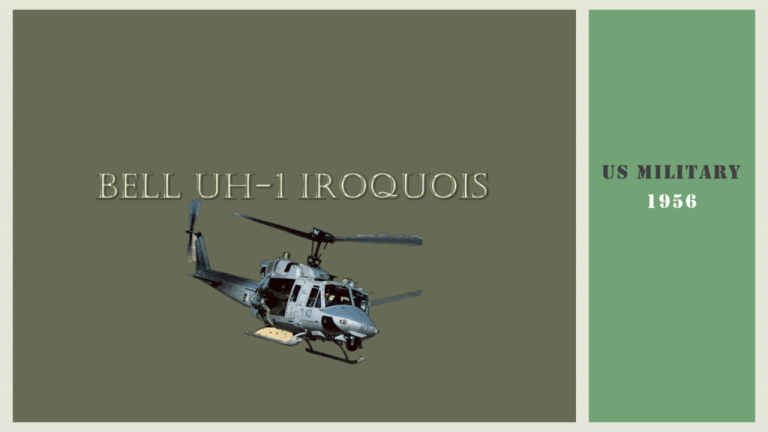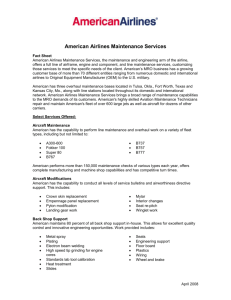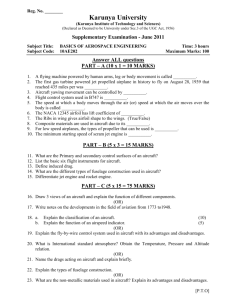File
advertisement

US MILITARY 1956 DEVELOPMENT In 1952, the Army identified a requirement for a new helicopter to serve as medical evacuation (MEDEVAC), instrument trainer and general utility aircraft. The Army determined that current helicopters were too large, underpowered, or were too complex to maintain easily. In November 1953, revised military requirements were submitted to the Department of the Army Twenty companies submitted designs in their bid for the contract, including Bell Helicopter with the Model 204 and Kaman Aircraft with a turbine -powered version of the H -43. On 23 February 1955, the Army announced its decision, selecting Bell to build three copies of the Model 204 for evaluation, designated as the XH-40 MODEL 204 Powered by a prototype Lycoming YT53 -L-1 (LTC1B-1) engine producing 700 shp (520 kW), the XH -40 first flew on 20 October 1956 Two more prototypes were built in 1957, and the Army had previously ordered six YH -40 service test aircraft, even before the first prototype had flown In March 1960, the Army awarded Bell a production contract for 100 aircraft, which was designated as the HU-1A and officially named Iroquois, after the native American nations The helicopter quickly developed a nickname derived from its designation of HU -1, which came to be pronounced as "Huey". The reference became so popular that Bell began casting the name on the helicopter's anti-torque pedals The official U.S. Army name was almost never used in practice After September 1962, the designation for all models was changed to UH -1 under a unified Department of Defense (DOD) designation system, but the nickname remained While glowing in praise for the helicopter's advances over piston -engined helicopters, the Army reports from the service tests of the YH -40 found it to be under-powered with the production T53 -L1A powerplant producing a maximum continuous 770 shaft horsepower (570 kilowatts) The Army indicated the need for improved, follow -on models even as the first UH -1As were being delivered. In response, Bell proposed the UH -1B, equipped with the Lycoming T53 -L-5 engine producing 960 shp (720 kW) and a longer cabin that could accommodate seven passengers, or four stretchers and a medical attendant. Army testing of the UH -1B started in November 1960, with the first production aircraft delivered in March 1961 MODEL 205 The Model 205 prototype flew on 16 August 1960 While earlier "short-body" Hueys were a success, the Army wanted a version that could carry more troops. Bell's solution was to stretch the HU-1B fuselage by 41 in (104 cm) and use the extra space to fit four seats next to the transmission, facing out. Seating capacity increased to 15, including crew The enlarged cabin could also accommodate six stretchers and a medic, two more than the earlier models In place of the earlier model's sliding side doors with a single window, larger doors were fitted which had two windows, plus a small hinged panel with an optional window, providing access to the cabin. The doors and hinged panels were quickly removable, allowing the Huey to be flown in a "doors off" configuration Seven pre-production/prototype aircraft were delivered and tested at Edwards AFB starting in March 1961. The 205 was initially equipped with a 44 -foot (13.4 m) main rotor and a Lycoming T53 -L-9 engine with 1,100 shp (820 kW). The rotor was lengthened to 48 feet (14.6 m) with a chord of 21 in (53 cm). The tailboom was also lengthened, in order to accommodate the longer rotor blades. Altogether, the modifications resulted in a gross weight capacity of 9,500 lb (4,309 kg). The Army ordered production of the 205 in 1963, produced with a T53-L-11 engine for its multi-fuel capability The prototypes were designated as YUH-1D and the production aircraft was designated as the UH-1D In 1966, Bell installed the 1,400 shp (1,000 kW) Lycoming T53 -L-13 engine to provide more power for the aircraft. The pitot tube was relocated from the nose to the roof of the cockpit, to prevent damage during landing. Production models in this configuration were designated as the UH-1H DESIGNS The UH-1 has a metal fuselage of semi-monocoque construction with tubular landing skids and two rotor blades on the main rotor Early UH-1 models featured a single Lycoming T53 turboshaft engine in versions with power ratings from 700 shp (522 kW) to 1,400 shp (1,040 kW) Later UH-1 and related models would feature twin engines and four -blade rotors All aircraft in the UH-1 family have similar construction. The UH -1H is the most-produced version, and is representative of all types. The main structure consists of two longitudinal main beams that run under the passenger cabin to the nose and back to the tail boom attachment point. The main beams are separated by transverse bulkheads and provide the supporting structure for the cabin, landing gear, under -floor fuel tanks, transmission, engine and tail boom. The main beams are joined at the lift beam, a short aluminum girder structure that is attached to the transmission via a lift link on the top and the cargo hook on the bottom and is located at the aircraft's centre of gravity. The lift beams were changed to steel later in the UH-1H's life, due to cracking on high-time airframes. The semi-monocoque tail boom attaches to the fuselage with four bolts The UH-1H's dynamic components include the engine, transmission, rotor mast, main rotor blades, tail rotor driveshaft, and the 42-degree and 90-degree gearboxes. The transmission is of a planetary type and reduces the engine's output to 324 rpm at the main rotor. The two -bladed, semi-rigid rotor design, with pre-coned and under-slung blades, is a development of early Bell model designs, such as the Bell 47 with which it shares common design features, including a dampened stabilizer bar VARIANTS All Information Provided from Wikipedia.org XH-40 YH-40 HU-1A TH-1A XH-1A HU-1B NUH-1B UH-1C YUH-1D UH-1D HH-1D UH-1E NUH-1E TH-1E UH-1F TH-1F UH-1H CUH-1H EH-1H HH-1H JUH-1 TH-1H UH-1G UH-1J HH-1K TH-1L UH-1L UH-1M UH-1N UH-1P EH-1U UH-1V EH-1X UH-1Y



